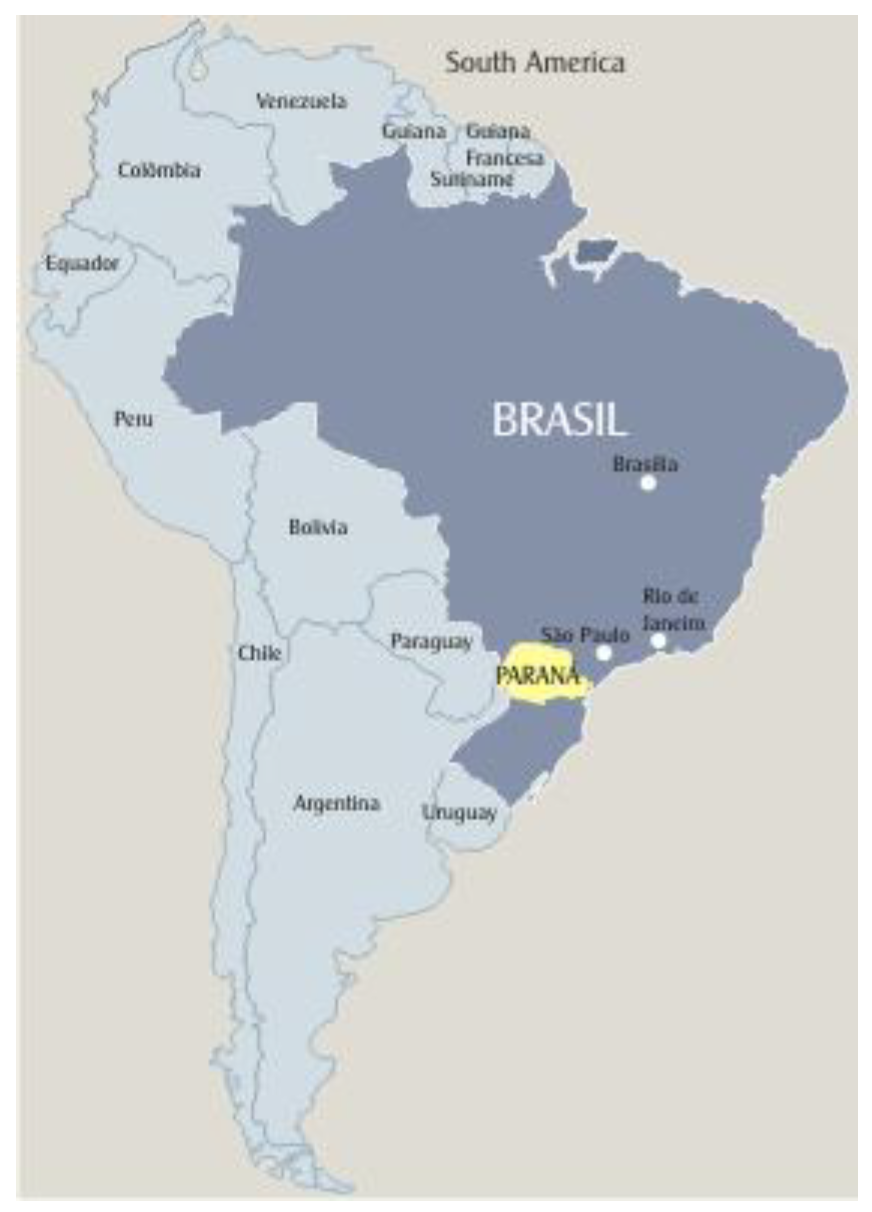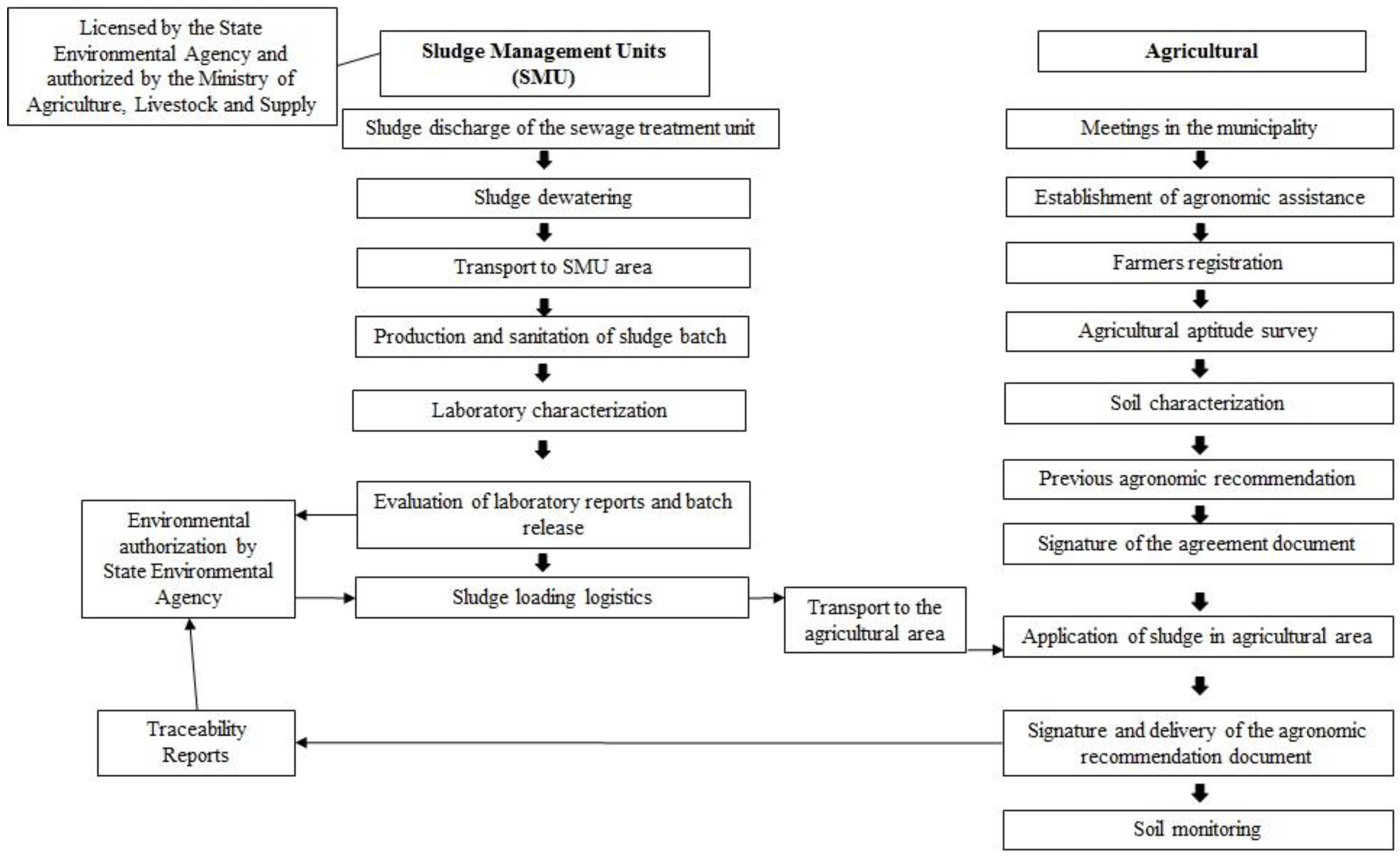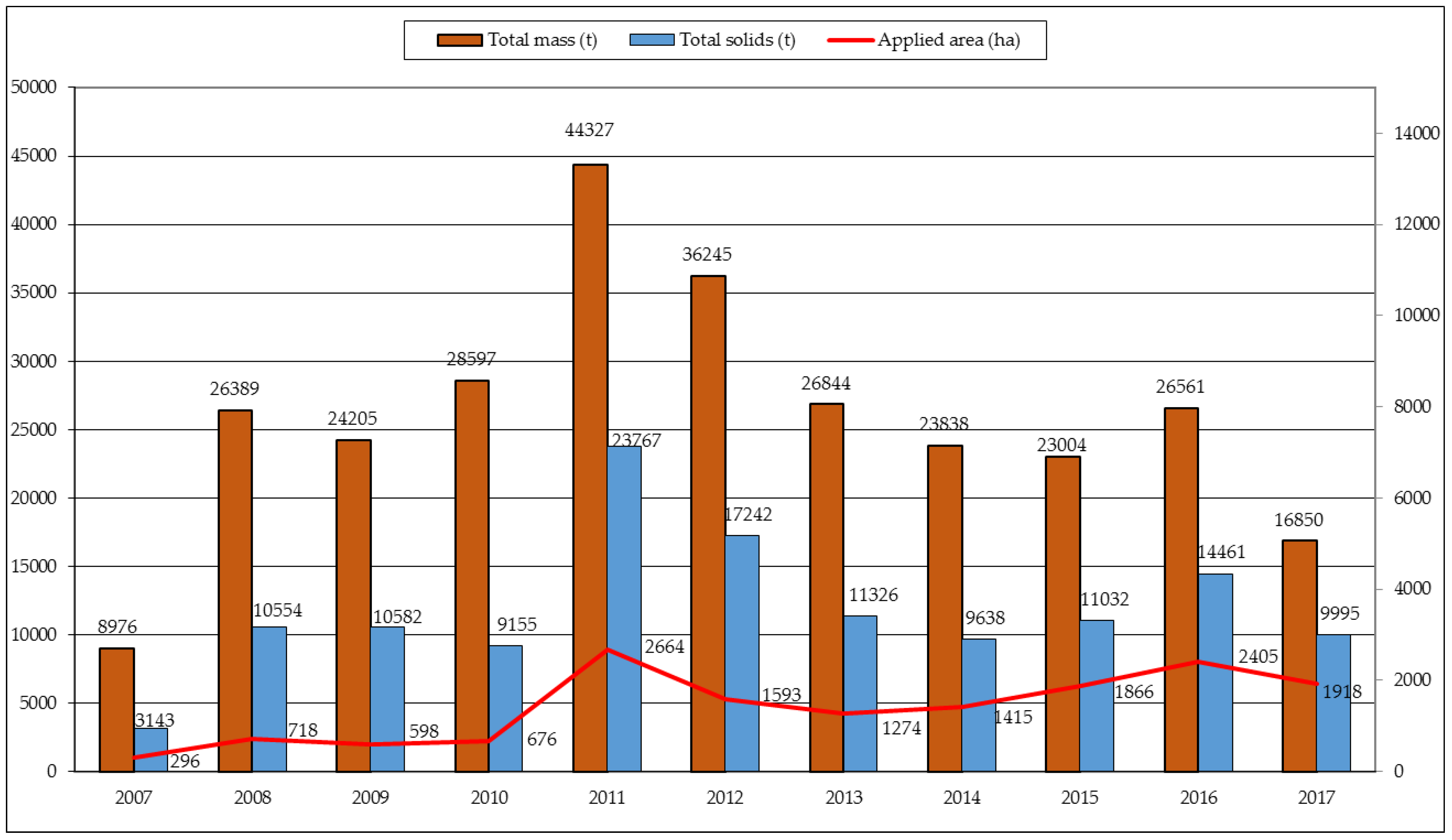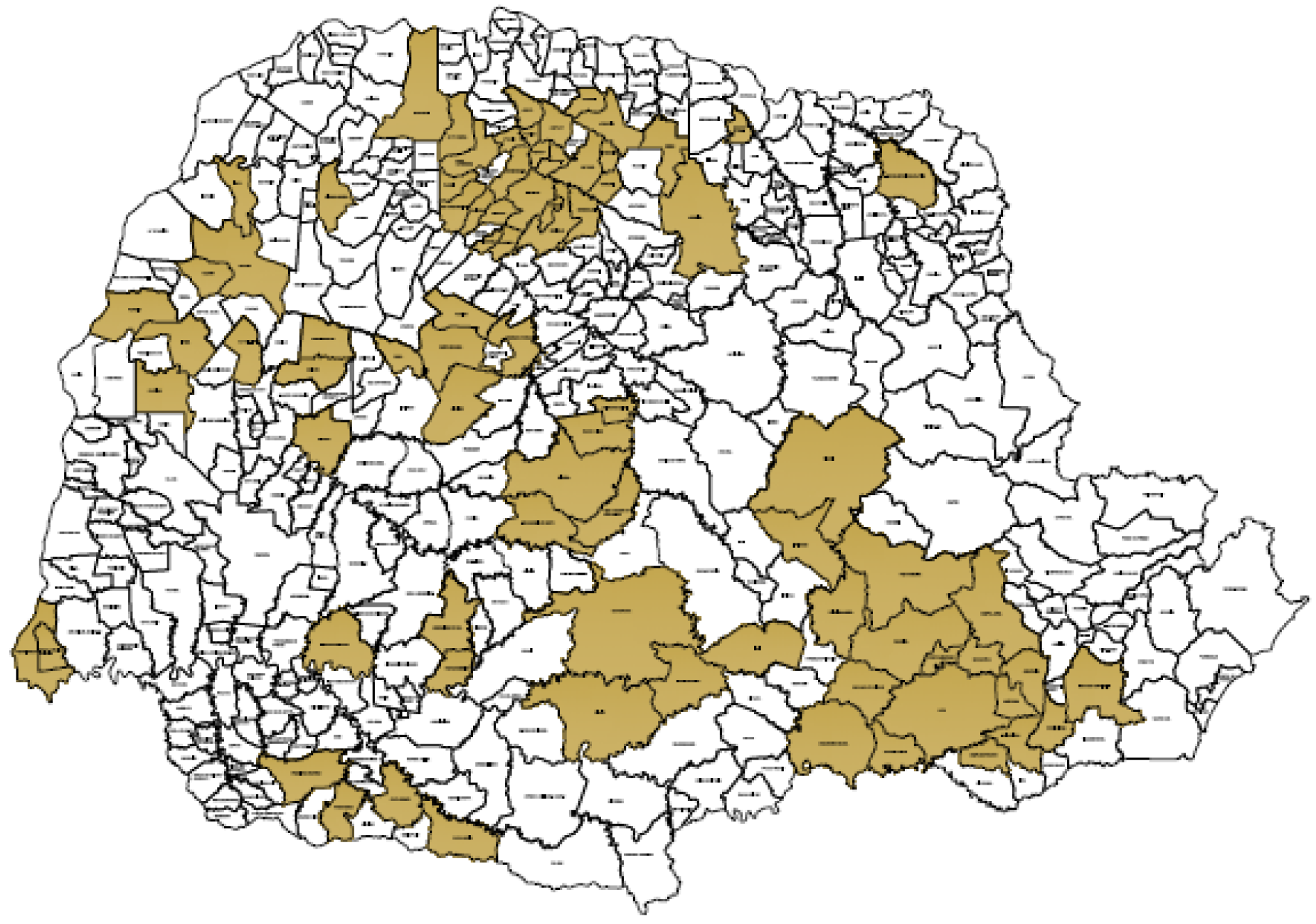Agricultural Use of Sewage Sludge in Paraná State, Brazil: A Decade of National Regulation
Abstract
:1. Introduction
2. Framework of Sewage Sludge Management in Paraná State
- availability of area and infrastructure for treatment and storage of the sludge;
- cost of transporting raw sludge from the STP to the place where the SMU is located;
- cost of laboratory analysis, considering that the higher the number of STP that compose a SMU, the lower will be this cost; and
- distance between the agricultural area and the SMU, factor that influences the cost of transportation.
3. Agricultural Use of Sewage Sludge in Paraná State
4. Difficulties and Challenges in Agricultural Use of Sewage Sludge in Paraná State
5. Conclusions
Funding
Conflicts of Interest
References
- Diário Oficial [da] República Federativa do Brasil. Available online: http://www2.mma.gov.br/port/conama/res/res06/res37506.pdf (accessed on 18 August 2017).
- Lara, A.I. Antecedentes. In Reciclagem de Biossólidos, Transformando Problemas em Soluções; Andreoli, C.V., Lara, A.I., Fernandes, F., Eds.; Sanepar: Curitiba, Brazil, 2001; pp. 14–19. [Google Scholar]
- Andreoli, C.V.; Von Sperling, M.; Fernandes, F. (Eds.) Lodo de Esgotos: Tratamento e Disposição Final. Belo Horizonte: UFMG-Departamento de Engenharia Sanitária e Ambiental; Sanepar: Curitiba, Brazil, 2001; p. 484. [Google Scholar]
- Paraná in Figures. Available online: http://www.ipardes.gov.br/index.php?pg_conteudo=1&cod_conteudo=3 (accessed on 22 October 2018).
- Instrução Normativa No 5, De 10 De Março De 2016. Estabelece As Regras Sobre Definições, Classificação, Especificações E Garantias, Tolerâncias, Registro, Embalagem, Rotulagem E Propaganda Dos Remineralizadores E Substratos Para Plantas, Destinados À Agricultura. Ministério Da Agricultura, Pecuária E Abastecimento; Poder Executivo: Brasília, Brazil, 2016.
- Ministério Da Agricultura, Pecuária E Abastecimento. Instrução Normativa SDA No 25, De 23 De Julho De 2009. Estabelece As Normas Sobre As Especificações E As Garantias, As Tolerâncias, O Registro, A Embalagem E A Rotulagem Dos Fertilizantes Orgânicos Simples, Mistos, Compostos, Organominerais E Biofertilizantes Destinados À Agricultura. Ministério Da Agricultura, Pecuária E Abastecimento; Poder Executivo: Brasília, Brazil, 2009.
- Brasil Instrução Normativa SDA No 35, De 4 De Julho De 2006. Aprova As Normas Sobre Especificações E Garantias, Tolerâncias, Registro, Embalagem E Rotulagem Dos Corretivos De Acidez, De Alcalinidade E De Sodicidade E Dos Condicionadores De Solo, Destinados À Agricultura; Poder Executivo: Brasília, Brazil, 2006.
- Relatório de Ação: Lodo de Esgoto-Fertilizante. Available online: http://arquivos.ambiente.sp.gov.br/municipioverdeazul/2016/07/pro-relatorio-acao-jundiai.pdf (accessed on 22 October 2018).
- Relatório de Administração e de Sustentabilidade. 2017. Available online: http://site.sanepar.com.br/sites/site.sanepar.com.br/files/relatorio_da_administracao_e_de_sustentabilidade_2017.pdf (accessed on 30 August 2018).
- Paraná—Secretaria de Estado de Meio Ambiente e Recursos Hídricos. Resolução Sema N. 021, De 30 De Junho De 2009. Dispõe Sobre Licenciamento Ambiental, Estabelece Condições E Padrões Ambientais E Dá Outras Providências, Para Empreendimentos De Saneamento; Diário Oficial: Estado do Paraná, Brazil, 2009; pp. 22–34.
- Presidência da República. Casa Civil. Subchefia para Assuntos Jurídicos. Available online: http://www.planalto.gov.br/ccivil_03/_ato2004-2006/2004/decreto/d4954.htm (accessed on 30 August 2018).
- Ministério de Agricultura, Pecuária e Abastecimento. Instrução Normativa no. 53, de 23 de outubro de 2013 (alterada pela IN MAPA no. 06 de 10 de março 2016). Available online: http://www.agricultura.gov.br/assuntos/insumos-agropecuarios/insumos-agricolas/fertilizantes/legislacao/in-53-2013-com-as-alteracoes-da-in-6-de-10-3-16.pdf (accessed on 30 August 2018).
- Agronomics and inorganics parameters of sludge, sanitized by alkaline stabilization, generated in systems containing anaerobic treatment processes of sewage: A case study of the State of Paraná, Brazil. Scientia Agraria. Available online: https://revistas.ufpr.br/agraria/article/view/48121 (accessed on 25 September 2018).
- Souza, M.L.P.; Ribeiro, A.N.; Andreoli, C.V.; Souza, L.C.P.; Bittencourt, S. Aptidão das terras do Estado do Paraná para disposição final de lodo de esgoto. Revista DAE 2008, 177, 20–29. [Google Scholar] [CrossRef]
- Bittencourt, S.; Ziliotto, M.C.S. Characterization of sewage sludge sanitized: A case study of the Paraná State, Brazil, from 2014 to 2015. In Proceedings of the 14th IWA Leading Edge Conference on Water and Wastewater Technologies, Florianópolis, Brazil, 29 May–2 June 2017. [Google Scholar]
- Silva, A.L.; Monção, S.H.; Vianna, R.; Nery, I.M. Alternativas de processo e disposição de lodo de esgoto na agricultura, considerando a atratividade econômica e benefício ambientais. In Congresso Nacional de Saneamento e Meio Ambiente; ABES: São Paulo, Brazil, 2017; p. 5. [Google Scholar]




| Parameters | Conama 375/06 | |||
|---|---|---|---|---|
| Limit in Sludge | Other Conditions | |||
| Agronomic TVS, TOC, TKN, NH4, NO2+NO3, P, K, Ca, Mg, S, Na (mg·kg−1·TS), pH, TS | NE | Application rate according to the nitrogen amount available in the sludge and the crop necessity. | ||
| Sanity | Thermotolerant coliforms (MPN·g−1·TS) | <103 | Sludge treated by one of the Processes to Further Reduce Pathogens, listed in the resolution. Prohibited on pastures (only after 24 months of the last application of sludge) and on cultivation of vegetables, tubers and roots, flooded crops, and crops whose edible part comes into contact with the soil (only after 48 months of the last application). | |
| Viable helminthes eggs (g−1·TS) | <0.25 | |||
| Salmonella sp. (in 10 g−1·TS) | absence | |||
| Virus (PFU or FFU·g−1·TS) | <0.25 | |||
| Inorganic (mg·kg−1·TS) | Arsenic | 41 | The theoretical accumulated load of inorganic substances by the application of sewage sludge (kg ha−1) must be respected. | 30 |
| Barium | 1300 | 265 | ||
| Cadmium | 39 | 4 | ||
| Chromium | 1000 | 154 | ||
| Copper | 1500 | 137 | ||
| Mercury | 17 | 1.2 | ||
| Molybdenum | 50 | 13 | ||
| Nickel | 420 | 74 | ||
| Lead | 300 | 41 | ||
| Selenium | 100 | 13 | ||
| Zinc | 2800 | 445 | ||
| Organic (mg·kg−1·TS) | 1,2-dichlorobenzene | NE | When such organic substance are detected in the characterization of the batch, the same substance in the soil should be monitored according to the criterion of the competent environmental agency. Concentrations in soil (mg·kg−1) must be observed. | 0.73 |
| 1,3-dichlorobenzene | 0.39 | |||
| 1,4-dichlorobenzene | 0.39 | |||
| 1,2,3-trichlorobenzenes | 0.01 | |||
| 1,2,4-trichlorobenzenes | 0.011 | |||
| 1,3,5-trichlorobenzenes | 0.5 | |||
| 1,2,3,4-tetrachlorobenzene | 0.16 | |||
| 1,2,4,5-tetrachlorobenzene | 0.01 | |||
| 1,2,3,5-tetrachlorobenzene | 0.0065 | |||
| Di-n-butyl phthalate | 0.7 | |||
| Di(2-ethylhexyl) phthalate (DEHP) | 1.0 | |||
| Dimethyl phthalate | 0.25 | |||
| Cresols | 0.16 | |||
| 2,4-dichlorophenol | 0.031 | |||
| 2,4,6-trichlorophenol | 2.4 | |||
| Pentachlorophenol | 0.16 | |||
| Benz[a]anthracene | 0.025 | |||
| Benzo[a]pyrene | 0.052 | |||
| Benzo[k]fluoranthene | 0.38 | |||
| Indeno[1,2,3-c,d]pyrene | 0.031 | |||
| Naphthalene | 0.12 | |||
| Phenanthrene | 3.3 | |||
| Lindane | 0.001 | |||
| Aldrin | NE | |||
| Dieldrin | NE | |||
| Endrin | NE | |||
| Chlordane | NE | |||
| Heptachlor | NE | |||
| Trichloroethane (DDT) | NE | |||
| Toxaphene | NE | |||
| Mirex | NE | |||
| Hexachlorobenzene | NE | |||
| PCBs | NE | |||
| Dioxins and furans | NE | |||
| Parameters | Limit in Sludge | Other Conditions |
|---|---|---|
| Thermotolerant coliforms (MPN·g−1·TS) | <106 | Sludge treated by one of the Processes to Significantly Reduce Pathogens, listed in the resolution. The use is restricted to coffee cultivation, silviculture, crops for the production of fibers and oils, with the mechanized application in ruts or pits, followed by incorporation. In case of manual harvesting, the application should be made at least 6 months before harvesting. Measures must be taken to restrict public access to the area for a period of 12 months after the last application and a sign must indicate the activities carried out on site. |
| Viable helminthes eggs (g−1·TS) | <10 | |
| Agronomic | The same as presented in Table 1 | |
| Inorganic | ||
| Organic | ||
© 2018 by the author. Licensee MDPI, Basel, Switzerland. This article is an open access article distributed under the terms and conditions of the Creative Commons Attribution (CC BY) license (http://creativecommons.org/licenses/by/4.0/).
Share and Cite
Bittencourt, S. Agricultural Use of Sewage Sludge in Paraná State, Brazil: A Decade of National Regulation. Recycling 2018, 3, 53. https://doi.org/10.3390/recycling3040053
Bittencourt S. Agricultural Use of Sewage Sludge in Paraná State, Brazil: A Decade of National Regulation. Recycling. 2018; 3(4):53. https://doi.org/10.3390/recycling3040053
Chicago/Turabian StyleBittencourt, Simone. 2018. "Agricultural Use of Sewage Sludge in Paraná State, Brazil: A Decade of National Regulation" Recycling 3, no. 4: 53. https://doi.org/10.3390/recycling3040053
APA StyleBittencourt, S. (2018). Agricultural Use of Sewage Sludge in Paraná State, Brazil: A Decade of National Regulation. Recycling, 3(4), 53. https://doi.org/10.3390/recycling3040053




